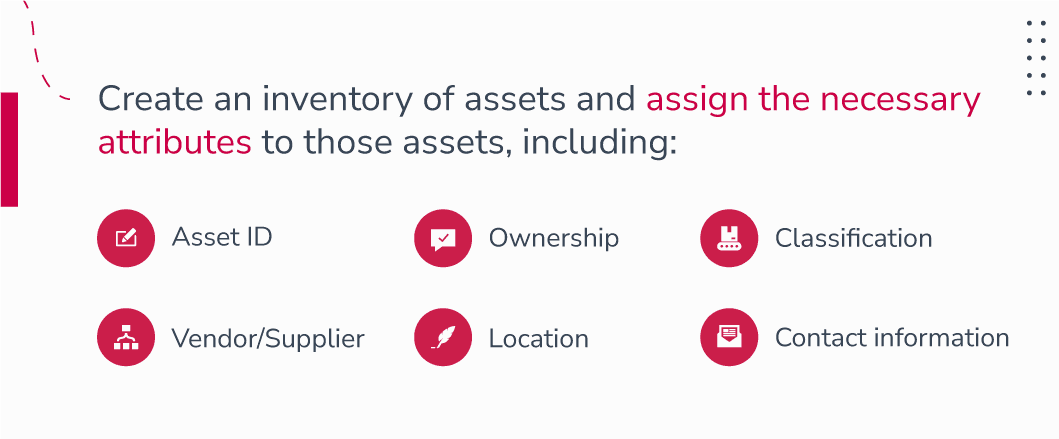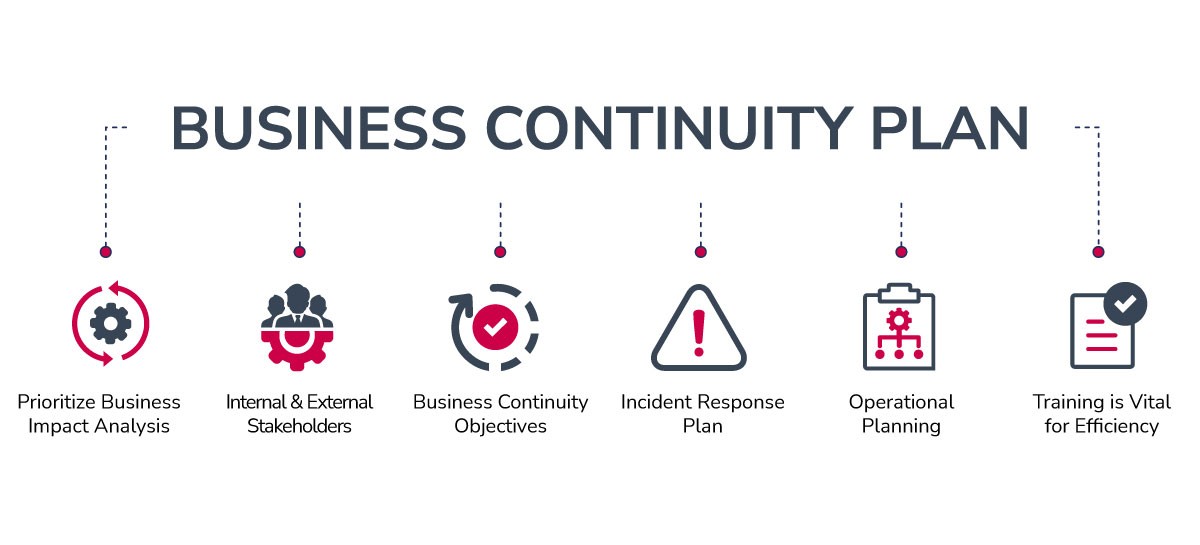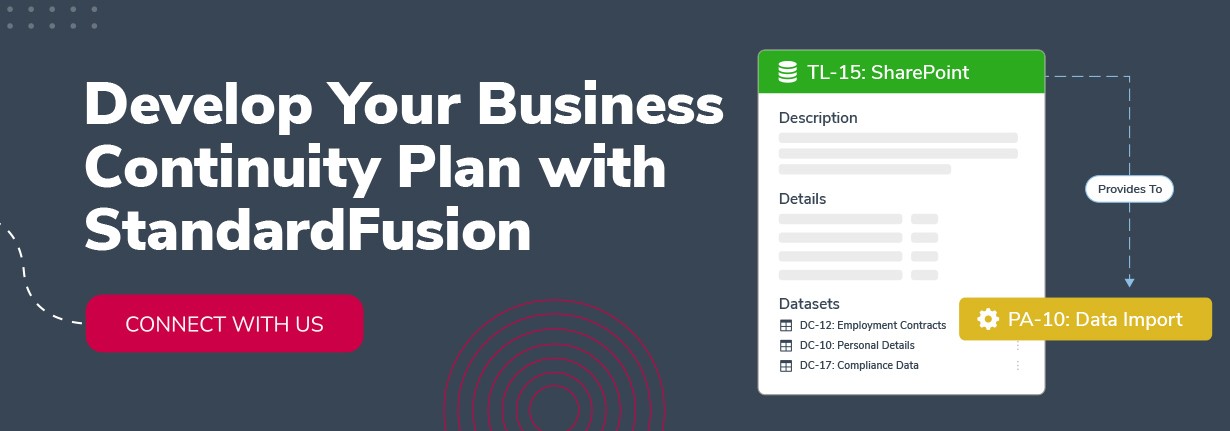Published on: Apr 4, 2023
Business Continuity Planning and GRC: Building a Resilient Company
Business continuity planning is not just about overcoming disruption. It's about ensuring that your organization can continue providing products and services to customers during an unexpected event.
In this article, you will learn why business continuity is vital for your business, the key components of a business continuity plan, and how you can use GRC tools to achieve resiliency.
Let's get started!
Article updated on January 25th, 2024
What is Business Continuity? The foundations
We can begin with a short, formal definition. According to ISO 22300, Business Continuity is the capability of an organization to continue the delivery of products and services within acceptable timeframes at predefined capacity during a disruption.
Let's explain this.
We can analyze this definition from a company's perspective so you can better understand what business continuity is and how to approach it.
The first exercise would be defining what are the assets your company holds and manages. Creating an inventory of assets and assigning the necessary attributes to those assets, including:
Asset ID
Ownership
Classification
Vendor/Supplier
Location
Contact information
Among your inventory of assets, not all of them can be categorized as critical. In the development of a robust business continuity strategy, the identification of critical assets is a pivotal step. This is essential for ensuring the resilience of an organization in the face of disruptions.
Critical assets are those elements within an organization that, if compromised or lost, would significantly impede its ability to deliver essential products or services.

How can Business Impact Analysis (BIA) help?
Conducting a Business Impact Analysis (BIA) is an effective method to pinpoint these critical assets. The BIA evaluates the potential impact of various disruptions on different business functions and processes, helping to identify dependencies and vulnerabilities.
By assessing the interdependencies between assets, the organization can prioritize resources and efforts to safeguard those elements crucial for maintaining core operations during adverse scenarios.
It is absolutely important for your company to operate and deliver its services. To do that, a Business Impact Analysis (BIA) can help you evaluate the impact of a disruption in your organization, including:
Causes of potential disruption, such as natural disasters or cyber attacks.
Departments that are core to your business operations.
People who would take the lead in responding to incidents.
Products or Services (based on revenue or other criteria) that would impact your organization's reputation and profitability the most.
After defining priorities, it should be part of the foundational work to document your Service Level Agreements (SLA) that can translate into acceptable timeframes. These SLAs are, most of the time, predefined in Master Agreements.
For SaaS companies, you can translate into RPO (Recovery Point Objective) and/or RTO (Recovery Time Objective). These two mean that you need to define what is the acceptable time of data loss your client would accept/expect and service outage time that would not impact revenue.
Here is something important:
ISO 22301: 2019 Security and Resilience sets a very reasonable and internationally acceptable baseline for Business Continuity Management Systems (BCMS) that you can be certified against.
A BCMS Manual is the basic document used to guide an organization to respond to disruption and resume, recover, and restore the delivery of products and services.
Critical Assets and BIA
For instance, in a manufacturing company, a critical asset could be a specialized production machine that is essential for meeting production deadlines. In a financial institution, critical assets might include servers hosting transactional databases crucial for daily operations.
Through the BIA process, the organization can quantify the potential financial, operational, and reputational impacts of the loss or compromise of these assets. By understanding the criticality of each asset, businesses can:
Allocate resources more effectively
Implement targeted risk mitigation strategies
Develop contingency plans that prioritize the recovery of these critical assets, thereby enhancing overall business continuity.

The Importance of Business Continuity in Business
First, let's review the 2 following terms:
Business Continuity Management System (BCMS): This is a holistic management process that identifies potential threats to an organization. Moreover, it helps identify the impacts those threats, if realized, could cause. It provides a framework for building organizational resilience with the capability for an effective response that safeguards the interests of its key stakeholders, reputation, brand, and value-creating activities.
Business Continuity Plan (BCP): This plan outlines procedures and instructions an organization must follow in the face of disaster, whether fire, flood, or cyberattack. It covers business processes, assets, human resources, business partners, and more.
Business Continuity from Various Perspectives:
You should look at Business Continuity from different perspectives, as a disruption might have different areas of impact.
From a business perspective, a Business Continuity Management System can enhance an organization's operational resilience by identifying critical business functions, dependencies, and vulnerabilities. Through this analysis, the organization can streamline internal processes, allocate resources efficiently, and minimize the impact of disruptions on its operations.
By assessing potential risks and developing strategies for mitigating them, a BCP becomes an integral part of an organization's risk management framework. It allows the organization to proactively identify and address potential threats, protecting not only day-to-day operations but also long-term business sustainability, including:
Support the organization's strategic objectives considering resiliency is a requirement for most SaaS providers;
Create a competitive advantage in case you become ISO 22301 certified, as your program provides better RTO and RPO than your competitors;
A BCP also improves customers' trust:
Service Continuity: A well-executed BCP ensures that essential services and products are delivered to clients even during unforeseen disruptions. This continuity instills confidence among clients, as they can rely on the organization's ability to meet their needs consistently, regardless of external challenges.
Enhanced Client Relationships: Demonstrating a commitment to business continuity sends a powerful message to clients about an organization's professionalism and dedication. Clients often prioritize working with partners who have robust risk management and contingency plans in place. This leads to stronger and more enduring client relationships.
Regulatory Compliance: In many industries, adherence to business continuity standards and regulations is a client requirement. Organizations with a comprehensive BCP not only meet these compliance expectations but also assure clients of their commitment to maintaining service levels, compliance, and data security.
What Are The Key Components of a Business Continuity Management System (BCMS)?
Having an inventory of assets is the first step to understanding the foundations of the business.
You must prioritize assets using a Business Impact Analysis. It will help you determine potential risks and people or departments.
Identify internal and external stakeholders that will take the lead on the processes or will be impacted by a disruption.
Business Continuity Objectives. Based on SLAs, what level of reliance do you aim to provide?
Incident Response Plan that covers everything from roles and responsibilities, playbooks (call-tree), and incident risk levels.
Operational planning must review the necessity of redundancy and other required resources.
Exercising is core. Training provided in different scenarios and documenting lessons learned is vital to evaluate the efficiency of a BCMS.

Developing a Business Continuity Plan With GRC
A Governance, Risk, and Compliance tool must be your centralized technology to manage your Business Impact Analysis.
There are significant benefits to consider when using a GRC tool in your risk management practice as part of your Business Continuity program:
You can embed risk assessment methodology in your GRC tool for consistent assessments. A risk assessment can help you identify and prioritize risks based on their potential impact and likelihood.
Access and visualization across departments and risk owners.
Improved ability to assign risks and document mitigation strategies or corrective action plans.
Reporting capabilities to better communicate risks across the organization with many different stakeholders (including top leadership).
Incident management capabilities to document disruptions and service outages.
A GRC software can be strategic if you want to simply keep your organization alive. Here, you can learn more about GRC and cybersecurity and how an integrated approach can help.
Advantages of Using StandardFusion's GRC Software
There are several advantages to using StandardFusion's GRC platform for business continuity management, including:
Comprehensive Risk Assessment: Identify and prioritize potential risks that could impact your business's ability to operate. This helps you develop a more effective business continuity plan by ensuring that all possible risks have been considered.
Customizable Workflow: Create and manage a set of procedures and protocols to ensure your organization can continue to operate in the event of a disruption. Customizable workflows will enable you to tailor your processes and protocols to your specific needs.
Continuity planning: You can design, create, and manage business continuity plans using our templates and following the industry's best practices. You can also automate the process of developing and updating plans, ensuring that they remain current and effective.
Compliance: Ensure compliance with regulations and industry standards related to business continuity. You can automate compliance assessments, track compliance with regulatory requirements, and provide reports on compliance status.

Key Takeaways
Business Continuity refers to an organization's capability to continue delivering products and services within acceptable timeframes during a disruption.
A Business Impact Analysis (BIA) would help you evaluate the impact of a disruption on your business's operations.
ISO 22301:2019 is a reasonable and internationally accepted baseline for Business Continuity Management Systems (BCMS).
Managing business continuity correctly will help you support your organization's objectives, increase customer trust, reduce legal exposure, reduce indirect disruption costs, improve your team's capability, and demonstrate control over risks.
Key components of a Business Continuity Plan include a Business Impact Analysis, identification of stakeholders, Business Continuity Objectives, an Incident Response Plan, operational planning, and training.
You can use a Governance, Risk, and Compliance (GRC) tool to manage Business Impact Analysis, prioritize risks, assign risks, document mitigation strategies, and communicate risks across the organization.
StandardFusion's GRC software provides comprehensive risk assessment, customizable workflows, continuity planning support, and compliance capabilities.
The bottom line?
An effective business continuity program will help you demonstrate to your clients that you want to provide the best possible service to them, even during potential disruptions.
Book a demo with our team and learn how a GRC software like StandardFusion can help you improve your ability to manage risks and prioritize corrective actions. Our GRC tool will enable you to design, create, and manage business continuity plans using templates and following the industry's best practices.
Also, you will be able to ensure compliance with regulations and industry standards related to business continuity.




